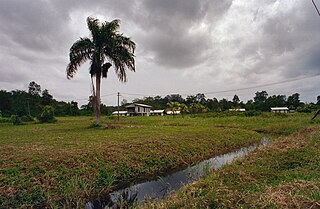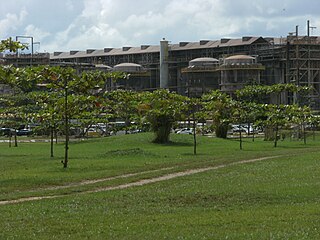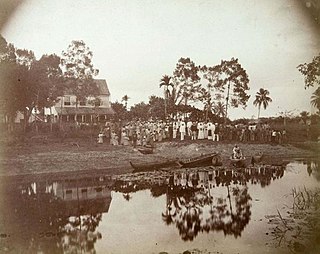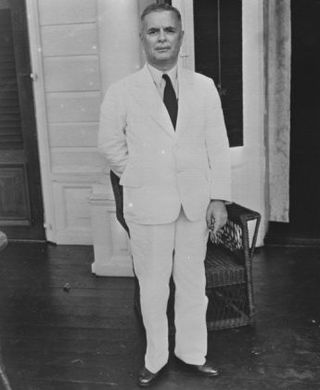
Paramaribo is the capital and largest city of Suriname, located on the banks of the Suriname River in the Paramaribo District. Paramaribo has a population of roughly 241,000 people, almost half of Suriname's population. The historic inner city of Paramaribo has been a UNESCO World Heritage Site since 2002.

Commewijne is a district of Suriname, located on the right bank of the Suriname River. Commewijne's capital city is Nieuw Amsterdam. Tamanredjo is another major town, while Meerzorg is the most populated.

Jodensavanne was a Jewish plantation community in Suriname, South America, and was for a time the centre of Jewish life in the colony. It was established in the 1600s by Sephardi Jews and became more developed and wealthy after a group of Jews fleeing persecution in Brazil settled there in the 1660s. It was located in what is now Para District, about 50 km (31 mi) south of the capital Paramaribo, on the Suriname River. Sugarcane plantations were established and Black African people were used as slave labour. At its height in around 1700 it was home to roughly 500 plantation owners and 9000 slaves. The colony faced regular attacks from Indigenous people, slave revolts, and even raids from the French navy. The community eventually relocated to the capital of Paramaribo. Clearing of grave sites and maintenance of the synagogue ruins has been attempted at various times from the 1940s to the 21st century.

Tapanahoni is a resort in Suriname, located in the Sipaliwini District. Its population at the 2012 census was 13,808. Tapanahoni is a part of Sipaliwini which has no capital, but is directly governed from Paramaribo. Tapanahony is an enormous resort which encompasses a quarter of the country of Suriname. The most important town is Diitabiki which is the residence of the granman of the Ndyuka people since 1950, and the location of the oracle.

Batavia on the Coppename River in Suriname is a former cocoa plantation, military post and state leper colony of the Dutch colonists. Batavia functioned as a leper colony from 1824 to 1897, after which the location was completely abandoned. Since 2001 it has been redeveloped as a place of pilgrimage and tourism.

Petrus Norbertus Donders was a Dutch Roman Catholic priest and member of the Redemptorist Congregation. He served in various missions in the Dutch colony of Surinam. He started working in the capital Paramaribo, but is predominantly known for his work in and around the leper colony Batavia, where he died in 1887. Peter Donders was beatified as 'Apostle of the Indians and Lepers' in 1982. The miracle needed was found in the cure of a Dutch child from bone cancer back in 1929.

Meerzorg is a town and resort (municipality) in Suriname, located on the eastern bank of the Suriname River, directly opposite the capital Paramaribo. Its population at the 2012 census was 12,405. Since 2000 it has been connected to Paramaribo by the Jules Wijdenbosch Bridge, named after the former President Jules Wijdenbosch.

Oost is a resort in Suriname, located in the Para District. Its population at the 2012 census was 8,016. The main town in the resort is Paranam. Oost is also home to the former leper colony Bethesda. The Paranam alumina refinery is located near the town of Paranam. The Accaribo area is becoming tourist spot with the main attractions White Beach and Caribo Beach Resort.

Zuid is a resort in Suriname, located in the Para District. Its population at the 2012 census was 6,113. The main ethnic groups are indigenous, Creoles, and mixed race.

Beekhuizen is a former sugarcane plantation and currently a resort in Suriname, located in the Paramaribo District. Its population at the 2012 census was 17,185.

Flora is a resort in Suriname, located in the Paramaribo District. Its population at the 2012 census was 19,538. Flora is both the name of the resort and the neighbourhood within the resort. Flora was founded as a wood plantation in 1809.

Livorno is a resort in Suriname, located in the Paramaribo District. Its population at the 2012 census was 8,209.

De Nieuwe Grond is a resort in Suriname, located in the Wanica District. Its population at the 2012 census was 26,161. Its main ethnic groups are East Indian, and Creoles. The resort is named after a sugar plantation in 1770. The plantation was already abandoned in 1863, when slavery was abolished, because that year, it was up for public auction. The area used to consist of small scale agriculture with a focus on vegetables and rice, but due to its proximity to Paramaribo, it has become a suburban area with a young population. In 2019, a new bigger market opened in the town.

Cornelis van Aerssen van Sommelsdijck was the first governor of Suriname after the establishment of the Society of Suriname in 1683. He was governor from 27 November 1683 until he was murdered by mutinous soldiers on 19 July 1688. Van Aerssen belonged to one of the richest families of the Dutch Golden Age.

Berg en Dal is a village in the resort of Klaaskreek in the Brokopondo District of Suriname. The village is located on the Suriname River.

Braamspunt is a nature reserve, fishing village, and a former military outpost in the Johan & Margaretha resort of the Commewijne District of Suriname. Braamspunt is the most western point of the Commewijne District at the combined mouth of the Suriname and Commewijne River. The capital Paramaribo is located to the south of Braamspunt. The name is a corruption of Byam's Point which refers William Byam who was a quartermaster of Willoughby.
The Brooskampers were a Maroon people, descendants of runaway African slaves, living in the forested interior of Suriname. The tribe is related to the Saramaka, and originated from Loango-Angola. The Brooskampers gained autonomy in 1863, but sold their land in 1917.

Kalebaskreek is an indigenous village of Kalina Amerindians in the resort of Calcutta in the Saramacca District in Suriname.

Uitkijk is a village in the resort of Kampong Baroe in the Saramacca District of Suriname. The village is located on the Saramacca River.

Johannes Coenraad Kielstra was a Dutch professor and Governor of Suriname from 1933 until 1944. During World War II, he increased his authority and imprisoned political opponents causing the resignation of all elected members of the Estates of Suriname. On 28 December 1943, he was given an honourable discharge by the Dutch government-in-exile. He served as Ambassador of the Netherlands to Mexico from 1944 until 1948.




















